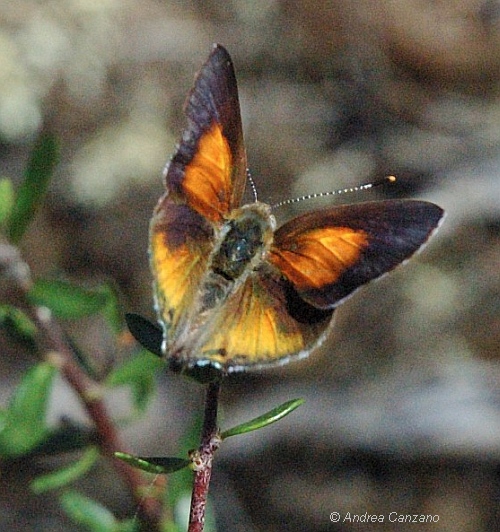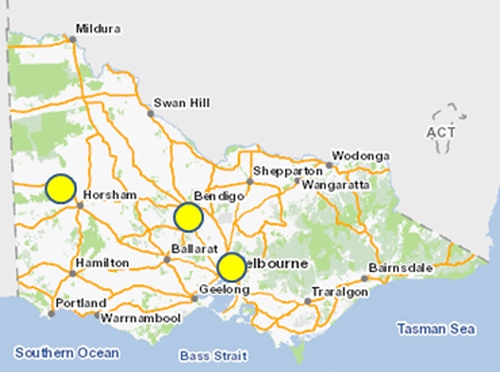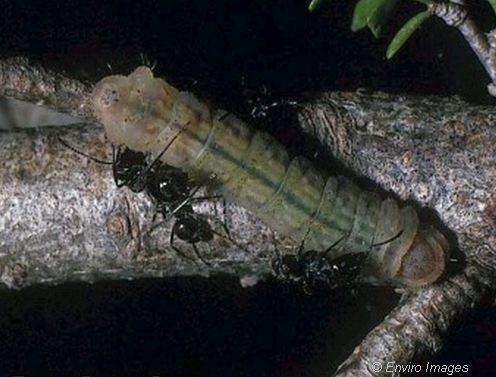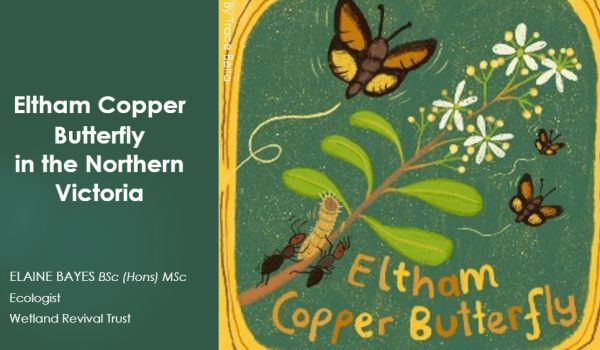Eltham Copper Butterfly
Eltham Copper ButterflyParalucia pyrodiscus lucida | |
|---|---|
| Kingdom: | Animalia |
| Phylum: | Arthropoda |
| Class: | Insecta (Hexapoda) |
| Order: | Lepidoptera |
| Family | Lycaenidae |
| Sub-Family: | Theclinae |
| Status | |
| Australia: | Endangered EPBC Act 1999 |
| Victoria: | Endangered (FFG Threatened List 2025) |
| FFG: | Listed; Action Statement No. 39 |

The Eltham Copper Butterfly (Paralucia pyrodiscus lucida) is only found in Victoria. It is one of the Lycaenidae family of butterflies or (blues) which have highly specialised ecological requirements. It is a close relative of the Dull Copper Paralucia pyrodiscus (Rosenstock 1885), and was recognised as a distinct sub-species by Crosby (1951). It was considered to have been extinct since the 1950's until rediscovered at Eltham in 1986.
The Eltham Copper is distinguished by the sharply defined, distinctively shaped patch of bright copper scales on the male hind wing.
Other related species:
Paralucia pyrodiscus pyrodiscus - more common in eastern Victoria, but only has an ill-defined central copper area of copper scales which varies from specimen to specimen.
Paralucia aurifer - the Bright Copper Butterfly which bears some resemblance to the Eltham Copper but occurs more in the southern areas of Victoria and extending into South Australia.
The conservation status of Eltham Copper Butterfly was increased in May 2016 when it was Listed under the EPBC Act 1999 as Endangered (EPBC Act 1999).
In Victoria, the Eltham Copper Butterfly was reassessed from Endangered (Victorian Invertebrates Advisory List 2009) to Critically Endangered (FFG threatened list 2022) and reassed as Endangered in Australia (FFG threatened list March 2025).
Lycaenidae family butterfly identification - Museum Victoria
Distribution

Eltham / Greensborough area - where about 10 sites exist across different tenure and management i.e. Parks Vic, Local Council and Private land.
Dimboola to Nhill in the Wimmera - known to have occurred in at least 6 sites on Crown Land at Kiata, Wail (including a road reserve), Salisbury Bushland Reserve, Gerang Gerung Mallee Dam and Gerang Gerung South Reserve.
The last confirmed records at Salisbury Bushland Reserve were in 1998 – the population is now considered extinct.
The most recent and significant discoveries were made in the 2022/23 season when surveys by the Wetland Revival Trust found an estimated 500 Eltham Copper Butterflies at two reserves in the Gerang Gerang area; Gerang Gerang Mallee Dam Flora Reserve (also known as Cattle Dam) and Gerang Gerung South Reserve. This area now contains the highest number of records in Victoria and is therefore the most important site for this species in the world.
Castlemaine / Bendigo - about 5 sites near Castlemaine within National Park, Botanic Gardens & State Forest and 6 sites near Bendigo within National Park and one on private land.
Discovery of the Eltham Copper Butterfly in the Bendigo area only occurred as recently as December 2007 near Big Hill on the Melbourne side of Bendigo in the Greater Bendigo National Park. The population was found by studying the flowering of Bursaria. Ants, in the genus Notoncus were also present.
Ecology & Habitat

larval phase of the Eltham Copper Butterly.
The Eltham Copper Butterfly is restricted to central and western Victoria where it is found in dry open woodlands. Its occurrence is dependent upon an obligatory association between a dwarfed form of the Sweet Bursaria Bursaria spinosa and colonies of Notoncus sp. of ants.
The Eltham Copper Butterfly is never found in areas where Notoncus ant colonies are absent.
Adult Eltham Copper Butterflies lay their eggs on the roots of Bursaria spinosa. Once the eggs hatch, the caterpillars are guarded by the ants, which lead them to and from the ant colony to browse on the Sweet Bursaria leaves. In return, the ants feed on sugar secretions which are exuded from the caterpillars' bodies. For detailed description refer to Crosby (1987) and Vaughan (1988a).
Threats
- Habitat loss is thought to be the prime reason for decline of this species. Particularly loss of the dwarf Sweet Bursaria and loss of habitat supporting Notoncus sp. of ants.
- Land clearing and stock grazing can reduced ground cover species. There are many cases where the Sweet Bursaria has been heavily browsed which retards ecological value for the Eltham Copper Butterfly.
- Wildfire or too frequent burning, particularly when in larval phase.
- Invasion by environmental weeds leading to degraded habitat.
Eltham Copper Butterfly filmed near Eltham, Victoria. It shows the unusual relationship with a particular species of Notoncus ant and a specific plant species, that being Bursaria spinosa. Colonies of this insect won't be found if either of these are absent.
Conservation & Management
Management and monitoring is focused on 12 populations in three geographic areas.
Eltham / Greensborough area
The population is mainly confined to 7 reserves managed by Parks Victoria and Local Government in the Eltham and Greensborough area, activities include;
- detailed population monitoring
- maintain open habitat through vegetation management and possibly timed ecological burning
- control Cape Broom, Boneseed and assorted grass weed species
Wimmera area
- Monitor both larval (late October, early November) and butterfly populations (late Dec, early Jan).
- Habitat inventory: Monitor regeneration at the Kiata site and compare this with any changes in the local Eltham Copper Butterfly population.
- Implement Rabbit and Brown Hare control programs at Kiata and Salisbury Reserves. Develop regulations for the Kiata Flora and Fauna Reserve that reflect its conservation significance.
- Implement weed control programs at Kiata and Salisbury Reserves.
- Revegetate sections of the Kiata Flora and Fauna Reserve
- In May 2006 DSE prepared a draft management plan for Salisbury Bushland Reserve for Golden Sun Moth and Eltham Copper Butterfly.
-
The Salisbury Reserve population is now considered extinct most probably due to over-grazing by sheep and loss of Sweet Bursaria, being the necessary host plant for the Eltham Copper Butterfly
-
Monitoring of 2 new sites at Gerang Gerung Mallee Dam and Gerang Gerung South Reserve which contan significant populations with the highest number of records in Victoria.
Bendigo / Castlemaine Area
In 2007 / 08 a new population of Eltham Copper Butterfly was discovered in the Bendigo area.
During 2009 / 2010 a considerable amount of survey work was carried out by a project officers and community groups resulting in 4 new sites being discovered.
In 2011 habitat mapping was carried out over 3,500 ha of reserve. Six new sites were discovered and a significant improvement in the understanding of habitat and prediction of habitat.
In 2012 additional work was undertaken to conduct counts of adult Eltham Copper Butterflies across all known sites in the Bendigo and Castlemaine areas.
In 2014 works undertaken to eradication woody weeds within the core habitat zones and enhance habitat.
Mapping in the Bendigo / Castlemaine Area has revealed sites ranged from 1.2 km to 7 km apart, sometimes disconnected by roads and areas of cleared land. There is a need to develop improved interconnectivity between populations.
There has been recent input into the fuel reduction burning in the Loddon Mallee region, altered timing of burns and exclusion zones have been established at 7 of the 11 locations to date.
Important Local Government Areas
- Banyule City Council
- Greater Bendigo City
- Hindmarsh Shire
- Nillumbik Shire
- Mount Alexander Shire
- Horsham Rural City

Projects & Partnerships
- Wetland Revival Trust - Eltham Copper Butterfly
- Friends of Eltham Copper Butterfly
- DSE, Parks Victoria, Deakin University
- North Central CMA
- Friends of Botanic Gardens, Castlemaine Field Naturalists
- Big Hill Primary School
- Julie Whitfield, Amaryllis Environmental 0400909073, amaryllisenvironmental@hotmail.com
References & Links
- Crosby, D.F. (1951) A new geographical race of an Australian butterfly. Victorian Nat. 67: 225-227
- EPBC Act (1999) Listing of Eltham Copper Butterfly, Australian Government.
- FFG Threatened List (2023) Flora and Fauna Guarantee Act 1988 - Threatened List - March 2025, Department of Energy, Environment and Climate Action (DEECA), Victoria.
- Victorian Flora & Fauna Guarantee Act 1988 Action statement - Eltham Copper Butterfly - pdf
- Victorian Invertebrates Advisory List 2009 - pdf, Department of Environment, Land, Water & Planning, Victoria.
- VBA (2019) Victorian Biodiversity Atlas, Department of Environment, Land, Water & Planning, Victoria.

